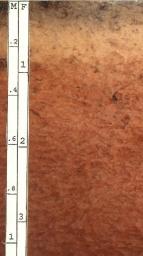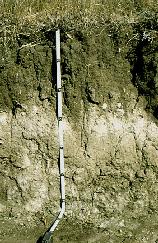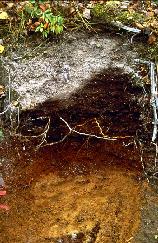Soil Forming (Pedogenic) Processes
The physical and chemical properties of a soil are determined by the soil forming process under which they form. Though all soils are created by the various horizon development processes of additions, transformations, translocation and removals, it is the soil forming or, pedogenic processes that determines the kind of soil that is ultimately formed.
Laterization
 Figure 11.15
This ultisol displays the
typical features of a soil having undergone laterization
Figure 11.15
This ultisol displays the
typical features of a soil having undergone laterization
(Image source: USDA NRCS. Used with permission)
The deep red to bright orange-red soils of the tropics are a product of laterization.
Laterization occurs in the hot, rainy tropics where chemical weathering proceeds at a
rapid rate. Soils subject to laterization tend toward the acidic and lack much organic matter as
decomposition and leaching is extreme. Exposure of the soil to the hot tropic sun by
deforestation bakes the soil dry, reducing infiltration, increasing runoff, and reducing
fertility.
Calcification
 Figure 11.16 Mollisol soil enriched with calcium carbonate
Figure 11.16 Mollisol soil enriched with calcium carbonate
(Image source: Agriculture Agri-Food Canada. Used with permission)
Calcification occurs in warm, semi-arid environments, usually under grassland vegetation. Soil tends to be rich in organic matter and high in soluble bases. The B horizon of the soil is enriched with calcium carbonate precipitated from water moving downward through the soil, or upward by capillary action of water from below.
Podzolization
Podzolization occurs in cool and moist climates under pine forests. They are typical of the colder portions of the humid continental and subarctic climates. The E horizon is heavily leached and basically composed a of light colored layer of sand.
Figure 11.17 Typical ashy, gray layer left from leaching of sesquioxides is apparent in this podzolized soil. (Image source: Agriculture Agri-Food Canada. Used with permission)
The upper portion of the B horizon is stained reddish color from the accumulation of sesquioxides. The profile gets lighter in color as depth increases. Podzolization of sandy soils in the southern United States has been the result of planting pine plantations.

